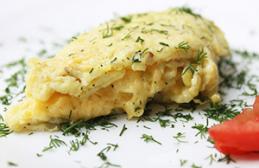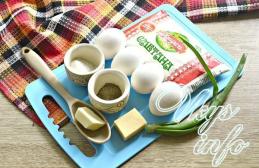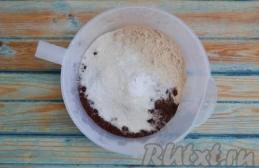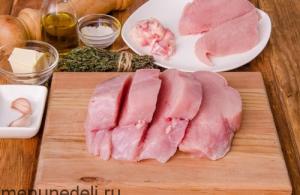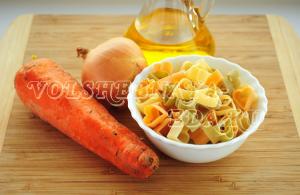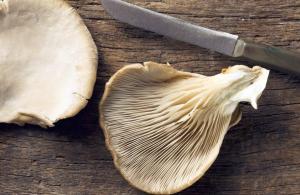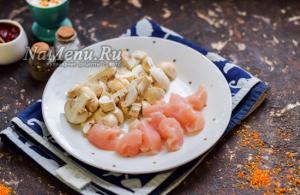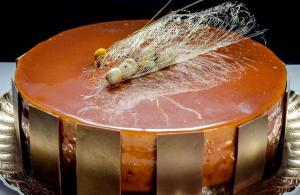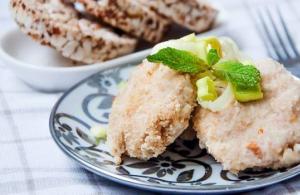For those who strive to spend a minimum of time in the kitchen, while trying to please their loved ones with high-quality homemade baked goods, we present a simple recipe for yeast-free Easter cake. A crumbly, tall, well-oiled and tasty product is surprisingly easy to prepare - you don’t need to separate and beat the whites into a stable foam, do multi-step work, fuss with yeast, labor-intensive kneading and long proofing, as for or.
Essentially, any yeast-free Easter cake is a cupcake decorated in the form of traditional Easter towers with a cap made of white icing. This recipe is no exception. The technology for preparing standard butter dough is used as a basis. Here, both the vanilla and creamy taste and the familiar cupcake texture are fully preserved. But the top protein coating with multi-colored sweet granules and additives soaked in aromatic alcohol transform Easter baked goods and make them festively elegant and solemn.
Ingredients: 
- butter - 200 g
- eggs - 4 pcs.;
- sugar - 200 g;
- flour - 300 g;
- baking powder - 1 teaspoon;
- vanilla sugar - 10 g;
- raisins - 100 g;
- candied fruits - 100 g;
- cognac or rum - 50 ml.
For the glaze:
- protein - 1 pc.;
- lemon juice - 1-2 teaspoons;
- powdered sugar - 100-150 g.
Yeast-free Easter cake recipe
- Pour raisins and candied fruits with cognac or other alcohol a couple of hours before cooking. Allow the additives to soak in the aromatic liquid.

- Preparing yeast-free dough for Easter cake. Take the butter out of the refrigerator and let it soften naturally at room temperature. Combine the melted bar with simple and vanilla sugar. Beat with a mixer until fluffy and almost completely dissolved solid grains. Add the eggs one at a time, continuing to vigorously beat. Add each next egg after the previous one has been completely absorbed.

- Mix flour with baking powder and sift into the butter mixture. Stir and remove all dry areas. The dough becomes thick and heavy. There is no need to knead the yeast-free cake dough for a long time - as soon as all the flour has dispersed in the butter mixture, move on to the next step.

- Drain the alcohol-soaked additives in a colander, then add to the dough.

- Stir briefly - just until the raisins and candied fruits are distributed in the total mass.

- Distribute the thick dough into the molds, leaving free space for the cakes to rise. In this example, we use two standard paper containers with a diameter and height of 9 cm and one smaller one - with a diameter of 6.5 cm and a height of 8.5 cm. If the forms are tin, we first line them with parchment paper.

- Yeast-free Easter cakes do not require proofing, so we immediately send the forms with the dough into an oven preheated to 170 degrees. Bake for about 40-60 minutes - cooking time depends on the size of the molds. To check for doneness, pierce the center of the baked goods with a long wooden skewer - it should remain dry. Cool the finished cakes.

- Prepare the white glaze. Beat egg white with lemon juice. Gradually add powdered sugar, continuing to work with the mixer, until a thick white mass is obtained.

- Apply the glaze to the Easter cakes, sprinkle with colorful sprinkles and wait for the white crust to harden.

- Yeast-free Easter cake is ready!

Enjoy your tea!
There is very little left until everyone's favorite Christian holiday, Easter. Every family prepares for this holiday and it is always a pleasant task. Easter cakes, Easter cottage cheese, painted eggs are obligatory symbols of this holiday and their preparation is always treated with joy. And although Easter cakes can now be bought in stores, many housewives bake them themselves.
Of course, this process is troublesome and not easy; the dough for such baking is very rich, and it sometimes gives surprises to housewives. How many times has this happened to me - the cakes don’t rise and that’s it. After all, sometimes it depends not only on skill, but also on the recipe itself and the quality of the products. Maybe that’s why some housewives don’t take on such baked goods.
If this amount is not enough for you, then feel free to increase the ingredients, observing the proportions. I am sure that you will definitely get a yeast-free Easter cake, and the recipe with photos will help you with this.
And also, if you noticed, there is no baking soda or baking powder in the recipe. This surprised me at first too. Easter cakes rise due to well-beaten whites and yolks, so pay special attention to this. But if you want to play it safe, you can still add 1 tsp. baking powder. I baked without baking powder, my daughter baked with baking powder. My cakes were denser, hers were looser. Both were delicious. Therefore, decide for yourself which Easter cake structure you like best and, accordingly, add baking powder or not.
Easter baking - video recipe
Not only Easter cakes are baked at Easter; the festive table is often decorated with various pies. Watch the video for the Easter roll recipe.
Bon appetit!
Happy Easter to you. Good luck to you, happiness, health, love.
Elena Kasatova. See you by the fireplace.
Usually Easter baked goods are prepared with yeast, but what should those who do not have time to knead yeast dough for a long time and those who for some reason do not want to eat yeast baked goods do?
Yeast-free Easter cake is a real godsend for those who do not use yeast in their diet.
Of course, such baked goods turn out denser and less airy than those created according to the classic recipe. But its taste, texture and aroma are as similar as possible to real Easter cake. Thanks to cranberries, raisins and almonds, the Easter delicacy is very rich, aromatic and festive.
By covering the top of the dessert with sweet (colorful) glaze or decorating it to your liking, you will get an original and very beautiful pastry. It will serve as a good alternative to classic sweets and will diversify your Easter table. You can use any available products as decoration. Confectionery powder, mastic, chocolate, protein or lemon glaze, liquid molasses or marzipan mass - all these decorative items will allow you to create an unusually elegant and refined cake. We offer a very simple recipe for delicious Easter cake.
Ingredients
- Flour - 130 g;
- Sugar - 100 grams;
- Dried raisins, cranberries, almonds - 40 g;
- Baking powder - 1 tsp;
- Chicken eggs – 2 pcs.;
- Butter - 120 g.

Preparation
First of all, you need to knead the yeast-free Easter cake dough. The butter must be taken out of the refrigerator in advance so that it softens well. Place the melted product in a deep container and add granulated sugar. Grind the ingredients with a fork until smooth.

Add raw eggs to the butter mixture. The product must be fresh and of high quality, because the taste and texture of the cake will depend on this.

Sift premium flour through a sieve with small holes and mix with baking powder. Place the products in a container with the rest of the ingredients.

Place raisins and cranberries in a separate bowl and pour boiling water over them. Leave for 5 minutes, then drain the water and dry the berries by placing them on a clean towel. Grind the peeled almonds with a sharp knife. Place the prepared fruits and nuts in a common container.

Using a silicone spatula, gather all the ingredients into a single lump. The workpiece should become homogeneous, but not dense.

Place the dough into a small cake pan. If you use special paper tools for Easter baking, they should be placed in ceramic dishes.

Preheat the oven to 180 C and place the forms with dough into it. Bake for 40-60 minutes until fully cooked. You can find out whether the mass is well baked using a wooden stick: pierce the cake with it as deeply as possible. If there are no sticky pieces of dough left on the device, the delicacy is ready.

Cool the simple yeast-free Easter cake and remove it from the mold. Decorate at your discretion.

Note to the owner:
- You can use any other sweets and fruits as a filler. These can be chocolate drops, coconut flakes, dried apricots, prunes, candied fruits and much more.
- Lemon and orange juice, almond and vanilla essences will help diversify the taste of holiday baking.
- When you decide to prepare a holiday treat for the first time, it is better to use the smallest baking dishes. In them, the cake is always baked evenly. Having mastered the cooking technology, the size of the molds can be increased at your discretion.
On the wonderful holiday of Easter, not all housewives decide to take such an important step as preparing holiday baked goods at home. Most people are put off by the very thought of having to deal with yeast dough. Easter with yeast, whether live or dry, turns out very tender and airy. But for those who are terrified of messing with yeast cakes, we have found an excellent recipe that does not require their use. In addition, the undoubted advantage of yeast-free Easter is significant time savings.
Easter cake is a special holiday pastry, one might say “the highlight of the program,” so its preparation is an intimate affair, and every housewife is jealous of this sacrament. It is believed that yeast-free Easter cake is healthier than all its counterparts. Whether this is a legend, a marketing ploy or true, everyone can decide for themselves. Nevertheless, the recipe for Easter cake without yeast has a popularity that is only gaining momentum over the years.
In order for the cake without yeast to turn out great, you need to follow some “grandmother’s advice”:
- You need to start work in a good mood and a favorable environment.
- The flour must be sifted three times so that it is saturated with oxygen.
- It is better to stir with a wooden spoon.
- The oil is not very fatty and even better, slightly salted.
- The baking needs to be done on Thursday and the lighting on Saturday.
- Do not cover with anything for the first 2 hours after baking, let it cool completely, and only then cover with a cotton towel.
- Store in a cool place, but not in the refrigerator.
So, let's figure out how to make a delicious Easter cake without yeast.
Ingredients

- Wheat flour – 350 g (you can take one third whole grain)
- Kefir – 300 milliliters (without additives, preferably sour)
- Butter – 100 grams
- Granulated sugar – 150 g
- Baking powder – 4 level teaspoons or 1 baking soda
- Raisins – 100 gr. (seedless)
- Lemon zest (1 is enough)
- Optional – a package of vanilla sugar
Cooking method
Even a beginner in confectionery can master Easter cake without yeast; the recipe is quite simple to make. Having prepared the necessary things, you can begin.
We wash the dry fruit, dry it with a napkin and sprinkle with a handful of flour.

Sift the flour. Grate the lemon zest on the finest grater.

Combine soda or baking powder with kefir.

Add sugar and grated citrus peel to the melted butter.

Advice! If you want a more saturated color in the finished product, you can add a little turmeric. Add vanillin if desired.
Add raisins to the kefir mixture.

Add creamy citrus mixture. Knead the dough by adding flour. Do not stir for long, but intensively. The consistency should correspond to thick sour cream.

Grease a baking pan (paper), and line a metal pan with oiled parchment paper. Fill the molds to half the height.

Attention! Do not place the molds close to the baking sheet, otherwise the tops will stick together and ruin the aesthetic appearance.
Bake at 180 degrees for about half an hour if the weight is less than a kilogram. From one to one and a half kg we wait three quarters of an hour. If more than 1500 grams - 60 minutes.
As practice shows, it is better to do several small ones. It’s convenient in everyday life (you can treat your friends or set the table with several different-designed sweet treats) and it’s easy to bake and take out.
You can check whether the products are ready with a dry wooden stick. If the tip is wet and sticky, you need more time, if it’s dry, you can remove it. Remove from molds and leave to cool.

Easter cake without yeast is ready! There remains a small but very significant touch - preparation for.
Ingredients
- powdered sugar - 250 g
- egg white - 1 pc.
- 1 tsp lemon juice (can be replaced with a pinch of citric acid)
Cooking process
Place the cooled egg whites in a mixing bowl with a mixer.

Add lemon juice (without veins and seeds). We start working with the mixer at low speed. After half a minute, increase the speed to medium, and after the same time, turn on maximum speed.

While beating, add 1 tablespoon of powdered sugar. When the mass thickens and becomes stable, stop whipping. The glaze is ready for use, and the cake is ready for further decoration.

If, in addition to the glaze, you want to improve and decorate the cake without yeast with colored sweet balls, marzipan flowers, ground nuts, then this must be done immediately before the top layer has hardened.
I’ve already made it with yeast, and today I want to offer a recipe for Easter cake without yeast.
Kulich without yeast, unlike traditional ones, is prepared very quickly and at the same time it turns out undoubtedly healthier. It can be baked in the form of one large one, but it is better to make several small ones, so they will bake better and faster and will not settle.
After experimenting a little with the dough, I came up with this recipe, and I think it turned out very well. The taste and texture of the cake is reminiscent of yeast, it rises well in the oven. Try it, you will like it!
 Easter cakes without yeast and eggs
Easter cakes without yeast and eggs
Ingredients (for 5 small Easter cakes):
Easter cake dough without yeast:
- 300-350 g flour (you can use some whole grain flour)
- 300 ml kefir (preferably sour)
- 100 g butter
- 150 g sugar
- 1 teaspoon baking soda (or 4 teaspoons baking powder)
- 100 g raisins
- zest from one lemon
- packet of vanilla sugar (optional)
Glaze:
- 100 g powdered sugar
- 3 tbsp. spoons of lemon juice
- 2 tbsp. tablespoons (without slide) butter
How to cook Easter cake without yeast - recipe:
- Prepare all the necessary products for the test.
 Products for making yeast-free Easter cake
Products for making yeast-free Easter cake
- Wash the raisins, dry and sprinkle with flour.
 Raisin
Raisin
- If you use homemade molds, as in, then you need to prepare them in advance. Simply grease the paper forms with oil.

- Sift the flour for the dough to make the cakes more airy.

- Grate the yellow layer of lemon peel (zest) on a fine grater.
 Lemon zest
Lemon zest
- Combine kefir with soda, stir and leave for a couple of minutes. (If you are using baking powder instead of baking soda, you will need to mix it with the flour.)

- At this time, melt the butter. Add sugar and zest to it. (I also added 1/4 teaspoon turmeric for color, but in baking it can impart a red tint to the finished product, so it should be used with caution.) You can add more vanilla sugar for a more pronounced flavor.

- And add kefir and soda. Stir.
 Preparation of dough without yeast - liquid mixture
Preparation of dough without yeast - liquid mixture
- Combine the flour with the resulting liquid mixture and raisins. Stir with a spoon (not for long). The dough should not be too liquid.

- Fill the molds with dough to 1/2-2/3 of the height.
 Molds with dough
Molds with dough
- Place them on a baking sheet at a distance from each other and place them in an oven preheated to 180°C for 25-30 minutes (large ovens take longer).
- Remove the finished cakes (you can check readiness with a toothpick; it should remain dry) from the oven and cool. As you can see in the photo, they rose well, 2 times.

- Remove the Easter cakes from the molds.
 Easter cakes without yeast
Easter cakes without yeast
- They can be sprinkled with powdered sugar or brushed with icing. I will show you two types of lemon glaze, and you choose the one you like best. (You can also use the frosting from the recipe or any other frosting.)
So, we need powdered sugar, butter and lemon, from which we have removed the zest.

- 1st method: Melt the butter, add powdered sugar and lemon juice.
 Preparing the glaze
Preparing the glaze
- Cook, stirring continuously, for a couple of minutes. If the glaze is too thin, let it cool a little, it will become thicker. It holds up well on the cake, it turns out shiny and moderately hard.

- 2nd method: You can make lemon glaze without cooking (it will be softer). To do this, you just need to combine the melted butter, powdered sugar and lemon juice and stir well with a spoon.
 Lemon glaze
Lemon glaze
3rd method: Beat the chickpea broth (aquafaba) with powdered sugar until thick and apply to the cakes. This glaze will look the same as the white one. See also.
- Hot glaze prepared according to method 1 must be applied to the Easter cake and decorated immediately, because... it hardens very quickly, unlike the one that does not need to be cooked.
 Yeast-free Easter cake
Yeast-free Easter cake
Kulich in section:


